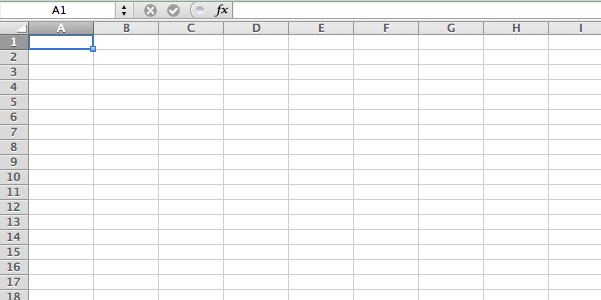Twitter as a blank canvas
Pretty much everyone has the same common experience when they first use Twitter: bafflement. You go, you sign up, you load the account and... what?
Of course, as we know from Nick Bilton's account of the early days of Twitter, this was pretty much how the people making it felt. They knew there was something here - probably - but what? Everyone had a different vision and the company twisted and turned for years (indeed, perhaps if it had been better managed it might not have worked).
As it turned out, the blank screen was really a blank canvas. You make your own Twitter. You can build a feed (and follower set) around fashion and makeup, or politics and journalism, or mobile tech (as I have). It's your mirror.
This means that that blank screen is perhaps better thought of as an empty development environment - Hypercard, perhaps, or (a metaphor that comes easier to me) an empty spreadsheet.
It can be lots of different things, but it's nothing until you start building.
This free-form character is quite different from other social networks. Very broadly, these divide into two categories: networks of people you know personally and networks of people interested in the same thing: Facebook or Yelp. Twitter is neither of these.
This leads to rather different dynamics for a new user - the 'on-boarding experience'. If you log into Facebook for the first time you don't have to create anything - your friends are already there. You just have to add them. Even more, on mobile social platforms such Whatsapp even this barrier isn't there: the app uses the phone address book to add people automatically, the photo library is shared, push notifications let you know when there's new stuff, and so all of the friction of a desktop social network falls away. The experience comes to you.
Equally, on a network of strangers such as Yelp, there's already lots of content from those strangers (restaurants, hotels or whatever), so again, there's no intimidating blank canvas.
On Twitter, though, you do need actually to go out and build something. Hence the stories about abandonment rates: people hear about it, create an account, write a few baffled tweets and get no further. What am I supposed to do with this?
However, once you're over that hump, Twitter might be much stickier than conventional social networks for actual friends (the Yelp model is rather different). There's not much to keep you on Whatsapp over Kik beyond the nightclub effect - that's where your friends are. But once you've build up a twitter feed around your interests, and a global network of people you've never actually met that you talk to, that's hard to replicate elsewhere.
This varies by use case, of course - if you only follow companies and celebrities that's easier to replicate elsewhere than if you've hunted out interesting and low-profile tech execs or makeup artists or experimental musicians, and of course are followed by the same.
One of the key challenges for Twitter to carry on growing, and become a truly mass-market platform, is to create things that help people over this hump - which also means mitigating an essential characteristic of the product. The contradiction is that the more that Twitter solves the on-boarding problem, the less sticky it may be. The less manual it is, the easier it is to make something similar.
Filters for twitter
The interesting superset of this 'freeform' question, to me, is what else can be done with all of this data. You made the spreadsheet, so to speak, and 200m people filled it up, and now what do you do? There are two things that occur to me.
First, there's the concept behind Twitter Music, which appears to have failed to gain traction but I think remains valuable. A app that acts as a filter to Twitter, pulling in all of a certain type of content, with structured data and content-specific tools. Music was one idea but any structured content might apply. The underlying problem, perhaps, is that before the death of RSS I was pretty sure that I was following 90% of the blogs that I would be interested in - but I'm equally sure I'm only following 10% at most of the people I would be interested in on Twitter. How can you manage the flow? I can't read everything, but a transient feed of tweets from people I find by hand (or even with a recommendation engine) is only one solution. Music? Video? What other forms can be systematised in this way? (There are already third parties trying to do 'buzz analytics'.)
The second is the contrast with LinkedIn. It seems to me that LinkedIn has (obviously) very rich data about each individual, but very poor data about the links between them. I'm connected to that person, yes, but do I really know them? If I want an introduction, does the intermediate contact know either me or the person I want an intro to, or is it a weak-weak connection? Products like Endorsements and Intro are clearly attempts to change this by gathering better, non-binary data about relationships between individuals, but it's not clear how well they'll work.
Conversely, Twitter has very strong data about connections between people, but very weak information about who they are. My Twitter bio is fairly informative, but many aren't, and all lack the richness of a LinkedIn profile. In fact, the only really properly structured data in Twitter is the character of relationships.
Hence, LinkedIn can tell me if X works at Yco and what they do there, and that someone I vaguely know has an indeterminate connection to them. Twitter knows that I'm followed by X, and he clicks all my links and retweets half what I say - but there's no way for me to see that and Twitter doesn't necessarily know he's at Yco at all. How to solve that?

